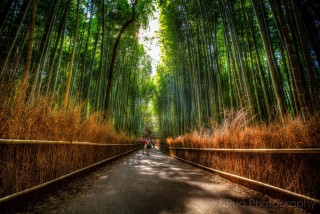Loading
Search
▼ Kyoto Sagano Bamboo Forest
- Category:Tourism

In Japan's Sagano Bamboo Forest, on the outskirts of Kyoto, towering green stalks of the famously versatile plant sway in the wind, creaking eerily they collide and twist, leaves rustling.
The sun filters through the densely packed grove, projecting thin slashes of light onto the dozens of camera-clutching tourists shuffling down the wide trail that cuts through the middle of the forest as they awkwardly angle their shots, attempting to crop human forms out of their frames. Long gone are the days when you'd get this place to yourself. If you've ever clicked on a rundown of "places to see before you die" or a compilation of the most beautiful forests in the world, chances are you've seen a photo of Sagano.
Located in the gorgeous Arashiyama district of western Kyoto, the Sagano Bamboo Forest's popularity has expanded in recent years, coinciding with the growing number of Buzzfeed-esque articles that include it on superlative-heavy travel lists. Though it's the beauty of the bamboo that brings in the masses, those distinct rustling sounds have become an attraction in their own right.
A few years ago the Ministry of Environment included the Sagano Bamboo Forest on its list of "100 Soundscapes of Japan" -- a selection of everyday noises intended to encourage locals to stop and enjoy nature's music. For the best experience, it's best to head out early in the morning or late evening and avoid weekends completely, when Japanese day-trippers descend on the area -- especially in the fall and spring. (There's no admission fee and it's open 24/7.)
A 'major' temple and a film star's former home
Right outside the Bamboo Forest entrance is the northern gate of Tenryu-ji Temple (open daily, 8:30 a.m.-5:30 p.m., admission 500 yen, about $5), a UNESCO World Heritage Site and one of the Kyoto-gozan -- five major temples of Kyoto.
This is no coincidence. In Japan, Shinto shrines and Buddhist temples are often situated near bamboo groves, which are viewed as a clever means of warding off evil, while the bamboo is seen as a symbol of strength. Built in the 14th century by a shogun in honor of the passing of Japan's emperor, Tenryu-ji has one of the country's most incredible Zen gardens and is today the headquarters of the Rinzai School of Zen Buddhism.
At the other end of the Bamboo Forest trail sits Okochi-Sanso Villa (open daily, 9 a.m.-4 p.m., admission 1,000 yen), the former home of late silent film star Denjiro Okochi. A massive complex of gardens with plants and trees that are famed for catering to all four seasons, there's also a temple, study, tea hut and museum highlighting the life of Denjiro.
(source : cnn.com)
(picture : 500px.com)
- August 13, 2014
- Comment (0)
- Trackback(0)

